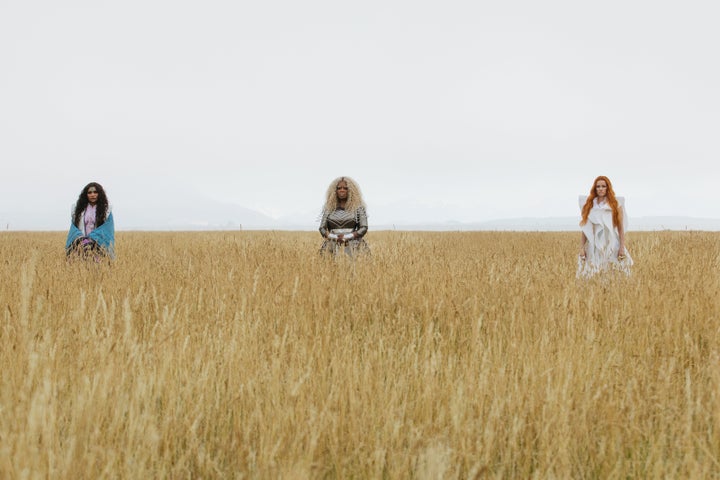'A Wrinkle In Time' Has A Grand Imagination, But It Can't Quite Put It To Good Use
Most fantasy tales include a spirit guide tasked with introducing the protagonist to the world he or she is entering. “A Wrinkle in Time” has three: wise Mrs. Which (Oprah Winfrey), quirky Mrs. Whatsit (Reese Witherspoon) and quotable Mrs. Who (Mindy Kaling), each bedazzled and glittered like phantasmagoric sorcerers.
They beam down to Earth from some other dimension to aid our 13-year-old heroine (Storm Reid), much like Hagrid takes Harry Potter to Hogwarts and Glinda the Good Witch gives Dorothy yellow-bricked marching orders in Oz. Once Hagrid and Glinda leave, their pupils use what they’ve learned to explore their surroundings alone, in turn illuminating the rules and geography and politics that govern the worlds they ― and we alongside them ― have entered.
“A Wrinkle in Time,” however, seems not to understand its world: There are no rules, no clear sense of geography and few politics other than elementary notions of good versus evil. When the Mrses depart, they leave behind shimmering altruism and narrow insight.
Ava DuVernay’s movie, like the spiritual Madeleine L’Engle novel on which it’s based, is rife with beautiful imagery: lush mountains, enveloping wheat fields, a trippy cubic prison on a planet where young Meg Murray’s enterprising scientist father (Chris Pine) has been stranded for four years. But the details needed to shift “A Wrinkle in Time” from an idea to an immersive landscape are fuzzy at best. Meg and her companions ― 6-year-old brother Charles Wallace (Deric McCabe) and schoolyard love interest Calvin (Levi Miller) ― travel through space and time via a tesseract, searching for her missing dad. Exactly what a tesseract is, and how it functions, and where it takes them, is under-defined, summed up in vagaries about lightspeed and quantum mechanics.
“It’s just a physics thing,” one character explains meaninglessly.
L’Engle’s book has long been considered hard to adapt, largely because of its heady science fiction packaged for young-adult readers. It’s understandable if the movie’s screenwriters, Jennifer Lee (“Frozen”) and Jeff Stockwell (“Bridge to Terabithia”), didn’t want to overload the story with exposition or concepts lost on the children Disney hopes will flood theaters this weekend. But for all its psychedelic imagination, DuVernay’s film lacks the world-building that makes fantasy special. It wears an earnest message on its sleeve ― believe in yourself and love those around you, and you’ll achieve your goals ― and leaves the fundamental building blocks at the door.
“A Wrinkle in Time” carries the unfair burden of “proving” itself as the first $100 million blockbuster directed by a woman of color ― especially one that features a mixed-race protagonist and female spirit guides. We live in an age where “Wonder Woman” and “Black Panther” become de facto litmus tests for our culture’s values. So what will it mean that DuVernay, a figurehead for diverse representation who proved her directing talents with the MLK biopic “Selma” and the micro-budget indie “Middle of Nowhere,” has crafted a costly spectacle that’s hardly wow-inducing? In theory, it shouldn’t mean much; white men have made far worse and failed upwards for decades. And not every skilled filmmaker is meant to helm giant studio movies anyway. Her career will be fine, even though the lure of a brilliant “Wrinkle in Time” feature is dampened.

As Meg and company get closer to reaching her father, who is held captive by a nefarious force called The It that strips the world of its goodness, the movie’s pieces practically refuse to snap into a singular whole. Characters zip from one planet to the next with little connective tissue, and we must accept each narrative jolt at face value. Don’t you know? It’s just the tesseract!
Reese Witherspoon shape-shifting into an oversized flower-dragon-slash-flying-carpet? Sure, that’s fun. Oprah’s stentorian boom delivering pithy counsel straight out of a “Super Soul Sunday” episode? Kinda soothing. Gugu Mbatha-Raw playing Meg’s brilliant mother? Can’t complain. “Scandal” veteran Bellamy Young popping up as a robotic Stepford wife in a dystopian cul-de-sac? Not sure why, but OK. Michael Peña portraying a red-eyed charmer who hypnotizes Charles Wallace so that he becomes a mouthpiece for The It? Well, Michael Peña’s always been an amusing actor to watch, at least.
And so it goes, one flashy sequence after the next. It’s been many years since I read L’Engle’s book, so I can’t dissect the faithfulness of this adaptation. But the limited cohesiveness only underscores how cloying its messaging can be. Which, of course, isn’t to say it’s not without merits ― in particular Storm Reid, who is captivating and perfectly cast in a role that requires a hefty emotional lift. She’s searching for the father she desperately misses, hoping to patch up the emptiness felt without his presence. It’s a story that fights against the constraints of childhood, when helplessness is a natural construct. Whether or not adults can forgive the capricious plot, Paco Delgado’s decadent costumes and Naomi Shohan’s vibrant production design are likely to enrapture the target audience. This is is a kids movie through and through, and I’d gladly take into account youngsters’ less cynical reviews when reconsidering “Wrinkle” down the line.

The thing is, kids movies needn’t be juvenile. That’s why we still talk about the intelligent world-building of “Harry Potter” and “The Wizard of Oz,” where social hierarchies and centralized governments are essential to the makeup. “A Winkle in Time” probably shares more DNA with “The NeverEnding Story” and “Mary Poppins,” but even those transposed real-world dynamics onto quixotic whimsy. This year alone, “Paddington 2″ and “Peter Rabbit” proved that children’s plots can be intricate and nuanced without sacrificing comprehensibility.
That’s not the goal of “Wrinkle,” though. It delivers messages instead of concepts, thinning the parable and neglecting to trust its audience unless the themes are enunciated at every turn. The messages are worthwhile, sure, but kids don’t need to be preached to the way this movie thinks they do, not even by Empress Oprah, who exacts a poise that’s miles away from her work in “The Color Purple,” “Beloved” and “The Butler.” By the time Meg returns home, her understanding of the universe’s alternate dimensions and metaphysical philosophy can’t be much grander than ours.
It’s possible I’m too hardened to appreciate the earnestness on display here. Others will surely embrace it without hesitation. And if Reese’s CGI carpet ride sweeps you up, well, then maybe it doesn’t matter whether you can define a tesseract. DuVernay will be OK, even if this time she produced something with more than a few wrinkles.
“A Wrinkle in Time” is out Friday.
RELATED…
Let’s block ads! (Why?)


